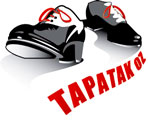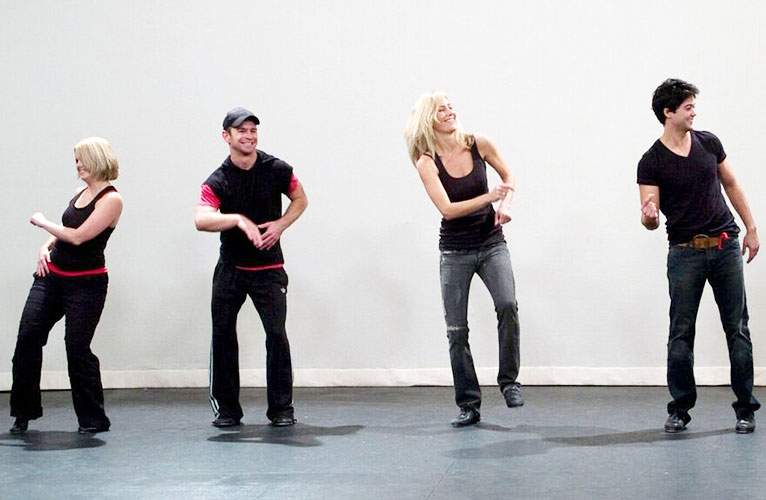By now I am sure you are all settled into your dance classes for the year so I thought we would talk about getting out there and discovering your own unique inner tapper! That creative voice that lives inside of you! Your own ideas, rhythms and concepts that are whizzing about in your head waiting for the chance to come out and play! Developing this unique sense of rhythm, creation and time can be heaps of fun and also makes you a more versatile and competent tapper. And the best way to do that is to get into the habit of improvising or jamming as often as possible.
Improvising and jamming are a huge part of the tap culture in the United States but for some reason it isn’t quite as popular in Oz which is a real shame, as this is the arena in which you develop your own rhythmic flair and affinity with different styles of music – and the confidence to tap solo!
Some of you might be reading this and wondering how you can get started. Well this is the easy part. All you need are your tap shoes and a good space to tap in.
First of all you might like to try some impro on your own to gain confidence. Just choose a piece of music and start tapping – it is as easy as that! Try and choose contrasting pieces of music to work with so you begin to recognize what steps go with what piece of music. For example – some steps will flow beautifully with a mellow piece of jazz music but won’t go at all with a rock based track. The rhythm of the steps you choose need to compliment and fit with the rhythm of the music to which you are dancing.
If you are finding it difficult to choose your steps you could perhaps ask an older student or teacher at your school to come and watch or join you for a jam and give you some direction and advice. As with all things in life, the more you practice the better you will become.
Once you have a little more confidence in your abilities you can invite a few people to join your group. Perhaps you can meet up for 20 minutes before or after your tap lesson each week. When you have your group together you could take turns at choosing the music for the jam. Simply stand in a circle and take turns at jamming! Each person goes into the centre of the circle and makes up some steps. You can either nominate a certain number of counts or bars of music for each person – say 32 counts each – or you can let each person tap for as long as they like. And that is it – too easy! Continue going around the circle one at a time until everyone has had as many goes as they like.
The more you do this the more comfortable you will become at recognizing the appropriate steps to suit the varieties of music. You will also notice that as time goes by you will do three things:
1. You will start to develop your own way or structure of putting steps together and your own style
2. You will stop replicating big chunks of tap chore that you have learned from other people in class and will instead be coming up with your own chore on the spot
3. You will notice that you are more confident holding the floor and tapping on your own
And don’t worry – it doesn’t have to be really complex at the beginning. Just start off simply and give yourself time to develop. Remember that in tap dancing – sometimes less is more – so don’t be afraid to pause sometimes and leave a few counts free. Leaving that space in the music can really add a lot of drama to your rhythm and give it a nice punch which keeps the audience or listener hooked! And watch what the other tappers are doing too – you can get oodles of new ideas from those around you!
OK – so now you are jamming up a storm and creating your own rhythms and moves. So now you can try jamming with another person at the same time. The key here is for one person to hold a really simple rhythm and then the other person to tap around this with a more complex pattern.
For instance Person One could simply tap the following:
1 : Stamp R foot to the side
&a2 : Shuffle L foot to the side and step in
&a3 : Shuffle R foot to the side and step in
&4 : Stamp stamp LR
5 – 8 : Repeat on other leg
1 – 8 : Repeat all again
Meanwhile the Second Person is tapping a much more complex rhythmic pattern over the top! For example:
1&&a : Heel dig, brush up, step heel] R
2& : Stamp L and R
3&&a : Heel dig, brush up step heel] x 2 – L R
4&&a
5& : Step step L R
6&&&a7 : Maxi ford L
&8 : Stamp stamp RL
& : Clap
You will notice in this example that the STAMPS from Person B compliment the STAMPS in the basic rhythmic pattern set down by Person A. And this is what you want to try and achieve when jamming with a second person. You want your rhythms to compliment what the other tapper is doing.
If Person A is accenting the counts of 2 and 5 Person B wants to come in with their accents on another count – say 1, 6 and 7! You can try this first just clapping the accents with a partner. Then occasionally, just to give the jam a bit of a kick – Person B can place their accent on the same count as Person A so it has real punch (practice both clapping on 1, 6 &7) Both people tapping can also signal to each other and stop and pause for a few counts – say stopping from 6 till 8 and then come back in on count 1! This is incredibly effective and will keep your audience hanging – and with more and more practice you will be able to communicate with your fellow jammers via the odd wink or signal so they can anticipate your every move!
You can take turns at setting and holding the base rhythm and at creating the complex filling over the top. It is fantastic fun and really develops your tapping abilities in a very special way.
Jamming is pretty cool and very addictive so if you haven’t given it a try before, get a few friends together and start your own JAMMING CLUB at your dance school!
Before you know it you will be HOOKED and your tapping will be improving at lightning speed!
I would love to hear from any of you out there who get a jamming club or jam session happening at your school. So drop me a line let me know how it goes!
Till next time! HAPPY TAPPING!
Christine


